Week 5 By Design: Breaking down the best plays from Sunday
Here's a look at the well-designed plays and schemes that made our list from Week 5:
Passing Design of the Week: Stafford-Golladay TD connection
The Detroit Lions improved to 2-3 on the year with a 31-23 victory over the Green Bay Packers, and the biggest story was receiver Kenny Golladay, who continued his emergence as a true threat in the passing game with four catches for 98 yards and a touchdown. Golladay's performance featured a highlight-reel catch and run with a stiff arm for good measure, but his touchdown reception below was a bit of design perfection.
Early in the fourth quarter, the Lions have a 10-point lead and face a second-and-goal on the Packers' 5-yard line. They line up with quarterback Matthew Stafford (No. 9) in the shotgun and use a three-receiver bunch to the right:
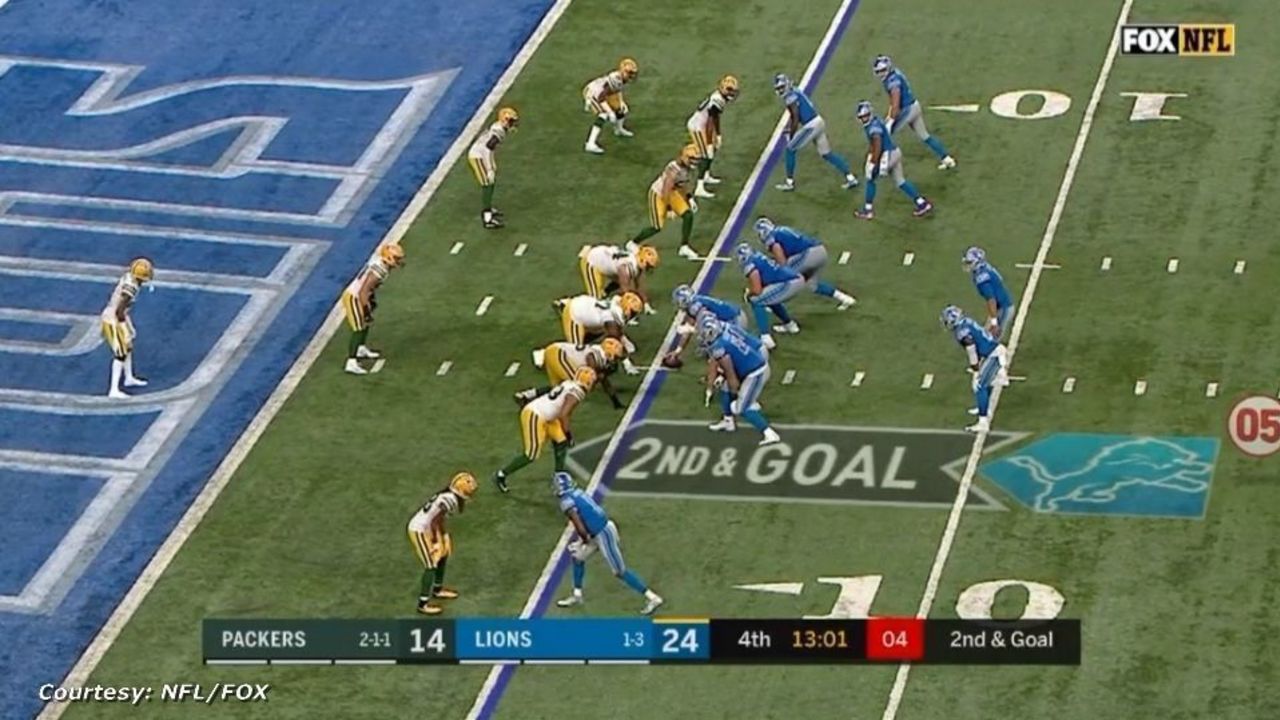
The Lions are using a trail (or follow) concept. All three receivers from the bunch work inside, but at different depths and with different timing:
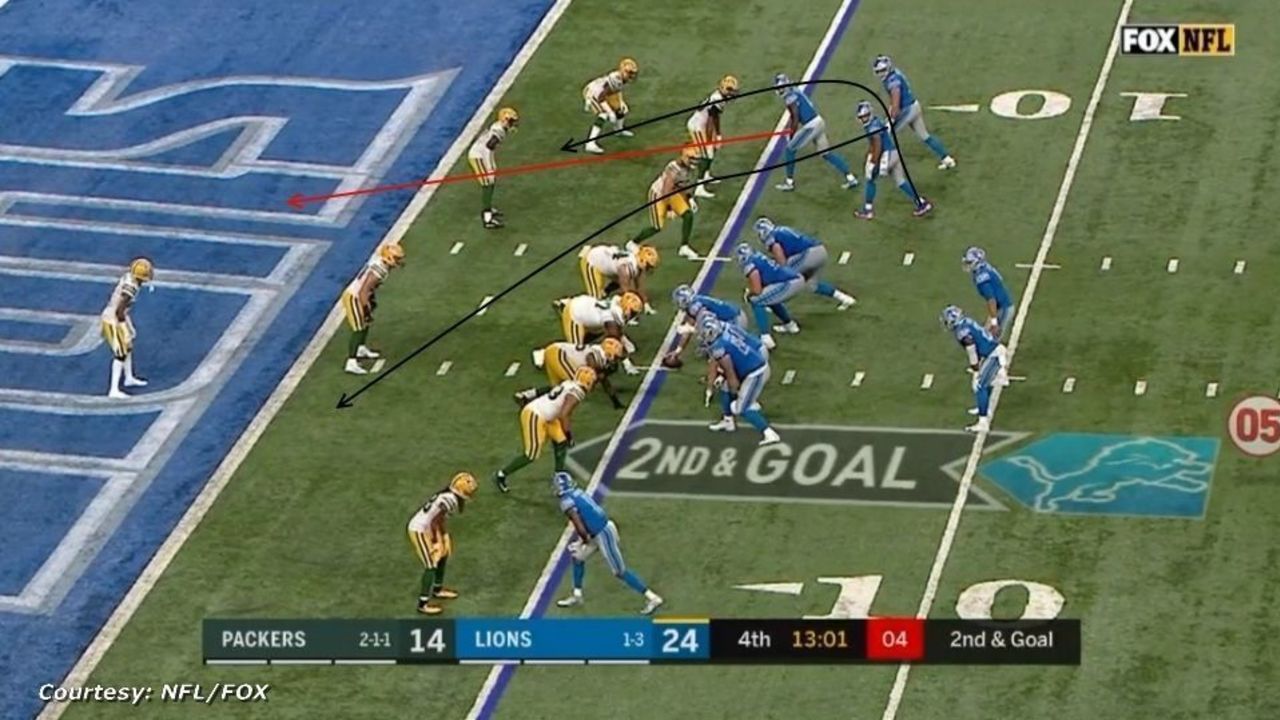
Golladay (No. 19) is at the line of scrimmage, and runs the deeper slant route. Behind him, Golden Tate (No. 15) is the inside receiver and runs the under route - first breaking outside and then trailing Golladay. In this case, the first route usually clears out space for the trailing receiver, but instead, Golladay simply beats his man and Stafford hits him in stride:
Thanks to great design and a precision strike from Stafford, the Lions extend their lead.
Rushing Design of the Week: Crowell's other long gain
The New York Jets' 34-16 win over Denver came largely on the shoulders - and legs - of running back Isaiah Crowell. He tallied 219 yards on just 15 carries, including a 77-yard touchdown early in the second quarter to put the Jets on the board. But here we'll highlight a 54-yard gain that came on the first offensive play of the third quarter. It was well-designed and well-executed, and gives us a chance to talk about "Duo."
Duo (or "doubles") is a running design that combines elements of power and zone-blocking schemes. It incorporates a pair of double-team blocks, working from the nose tackle toward the weak-side linebacker on the second level. Some call this "power without a puller" thanks to the pair of double-team blocks. But the zone element comes into play with the running back, as he must read the blocking up front, much like a zone play.
In this instance, facing a first-and-10 in their own territory, the Jets line up with quarterback Sam Darnold (No. 14) under center and Crowell (No. 20) as the lone back. Here's the Duo design:
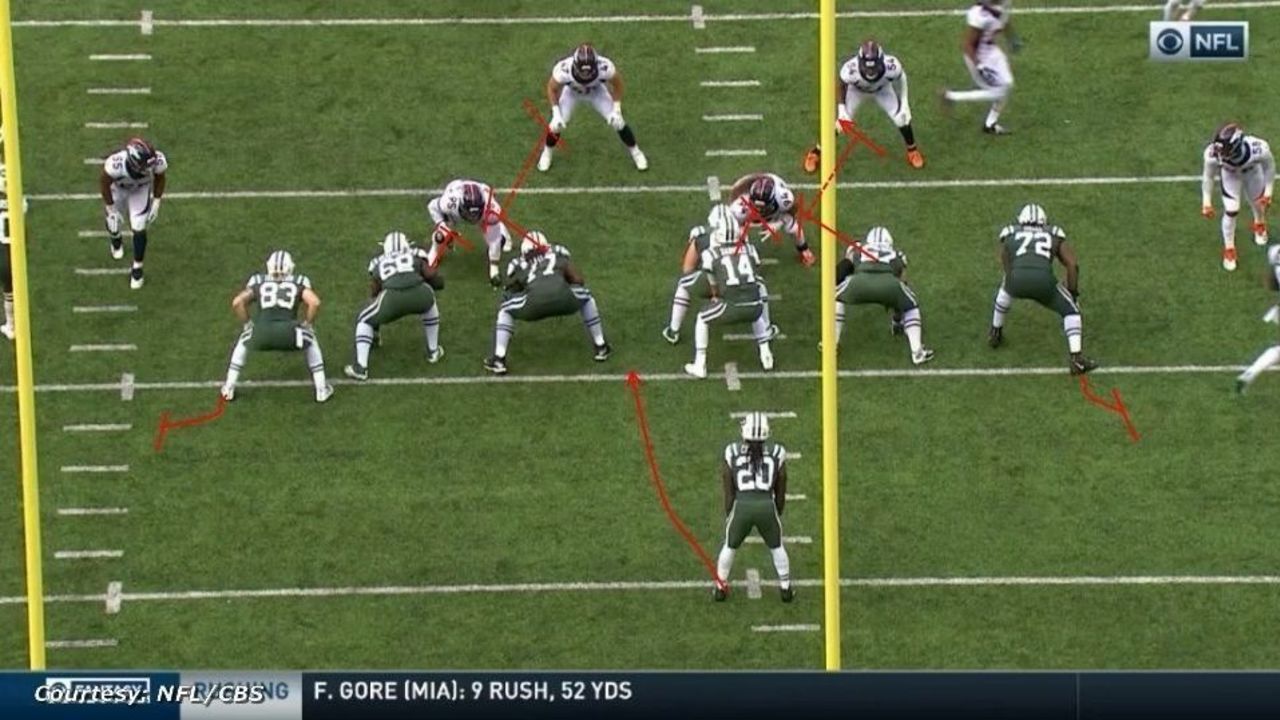
As you can see, the pair of double-team blocks work from the nose guard to the weak-side linebacker. That means left tackle Kelvin Beachum (No. 68) and left guard James Carpenter (No. 77) first block the defensive tackle aligned between them, before Carpenter quickly moves up to the linebacker. Center Spencer Long (No. 61) and right guard Brian Winters (No. 67) take on the nose guard before Winters flows to the weak-side linebacker.
After the snap, Crowell takes the handoff and reads how the blocks set up. He cuts left behind Beachum and after making the box safety miss, he races upfield for a 54-yard gain:
This view from the end-zone camera shows how the blocks are perfectly timed and executed:
Thanks in large part to their strong running game, the Jets were able to pull out the win. Duo was a big part of that.
Pressure Design of the Week: Bengals turn heat into TDs
Midway through the third quarter of their game against the Miami Dolphins, the Cincinnati Bengals trailed 17-0 and couldn't get anything going on offense. But thanks to two defensive touchdowns in the fourth quarter, Cincinnati came all the way back to pull out the 27-17 victory.
Both touchdowns were due to defensive pressure from the guys up front. On the first, quarterback Ryan Tannehill was pressured and his pass attempt deflected into the hands of Michael Johnson, who returned it for a 22-yard touchdown. After a Dolphins punt, the Bengals added a field goal to give themselves their first lead of the game at 20-17 ... and then their defense put the game away:
On this play, two elements combine that lead to the pressure and the defensive score. The first is the pre-play look from defensive end Carlos Dunlap (No. 96), who uses a "wide-9 alignment," putting himself well outside the right offensive tackle:

The second is the linebacker blitz, which aims to the inside of the right tackle:
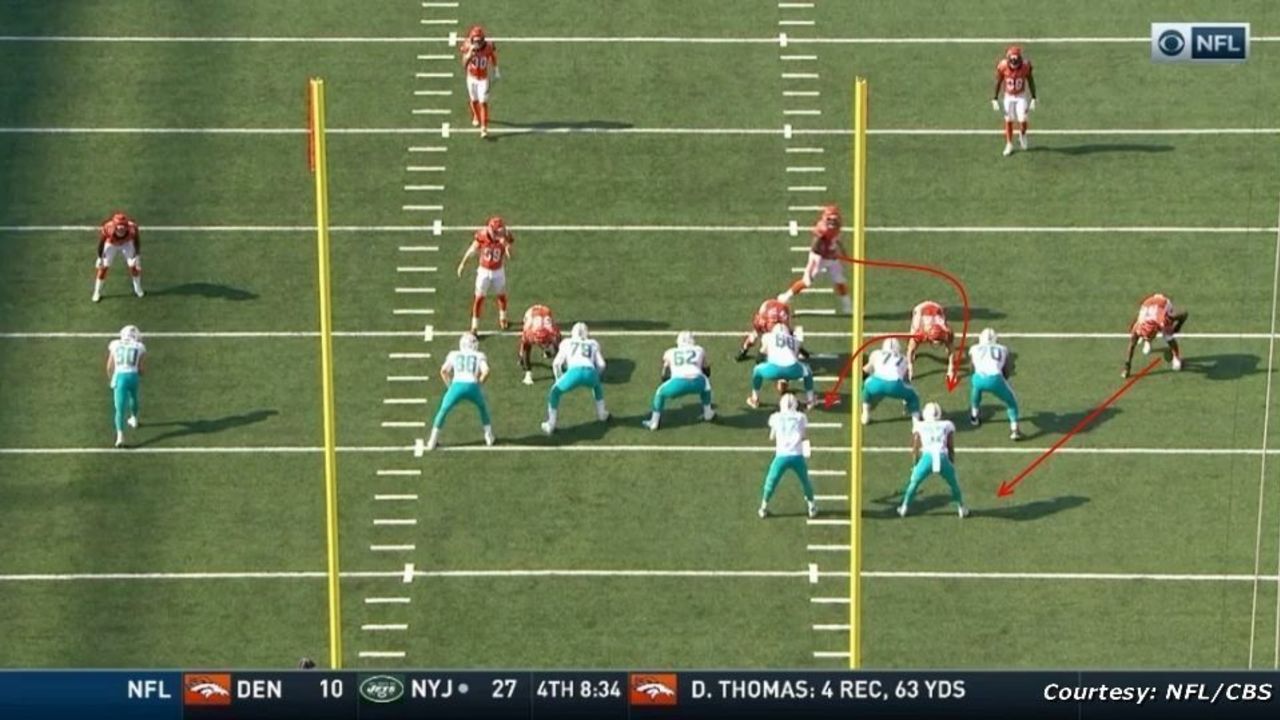
Those two factors put the right tackle on an island alone with Dunlap without any help from the running back, who's forced to pick up the blitzing linebacker. That allows Dunlap to work one-on-one, and he eventually gets around the end to Tannehill (No. 17), knocking the ball from his hands and into the waiting arms of rookie defender Sam Hubbard (No. 94), who returns the football for the score:
The win (coupled with the Baltimore Ravens' loss to the Cleveland Browns) kept the Bengals atop the AFC North for at least one more week, and now with sole possession. They can thank this well-designed play and Dunlap's execution for icing the victory.
Coverage Design of the Week: Adams confounds Manning
The Carolina Panthers pulled out a thrilling win over the New York Giants, as Graham Gano's 63-yard field goal in the closing seconds clinched a 33-31 victory. But it was safety Mike Adams' incredible performance earlier in the game that put the Panthers in position to prevail.
Adams notched the first of his two interceptions, which we'll review below, by fooling Giants quarterback Eli Manning and getting himself into the passing lane on a quick throw. Late in the third quarter, the Giants face a first-and-10 on the Panthers' 25-yard line. Manning (No. 10) aligns in the shotgun with Saquon Barkley (No. 26) standing to his left. Adams (No. 29) drops down to the line of scrimmage, appearing to show blitz:
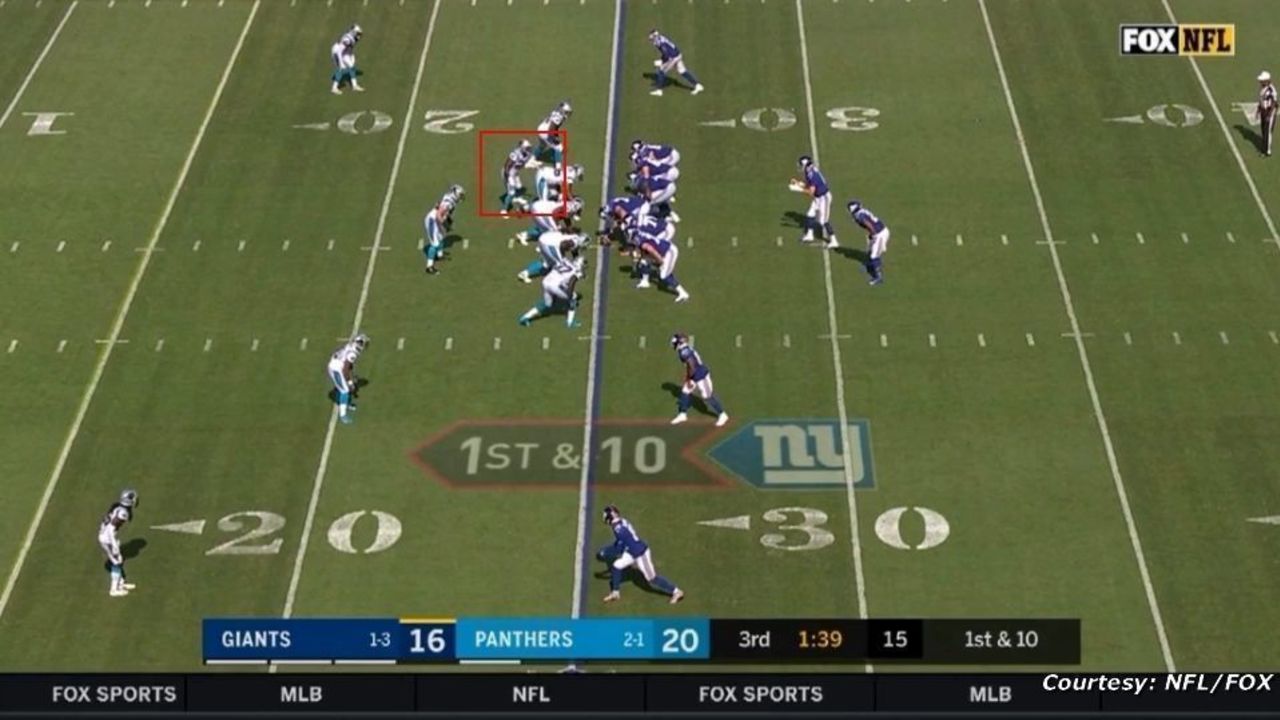
The Giants are in a run-pass option (RPO) look. Manning and Barkley will meet at the mesh point in the backfield, while the offensive line and tight end will block to the right for a potential run. But in this case, Manning wants to throw a slant route to Odell Beckham (No. 13), who's coming from the right:
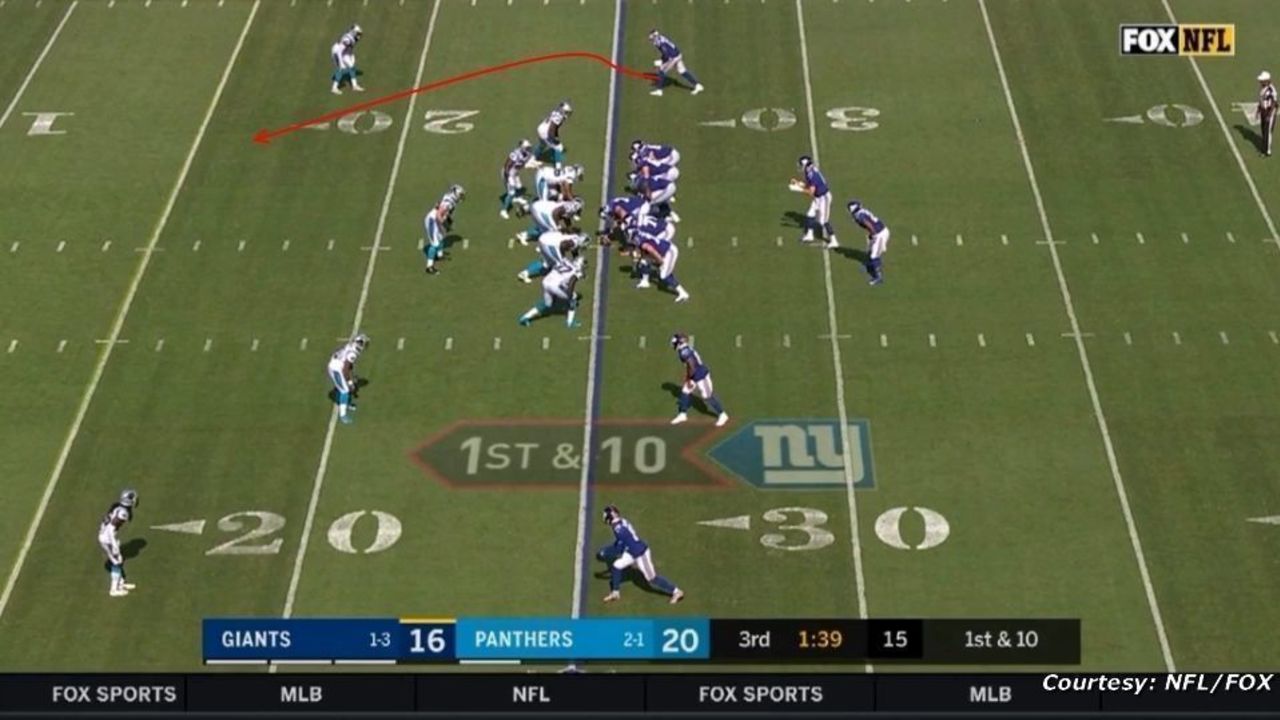
As more teams use plays like this, defenses have to adjust. One way is by making the decision for the quarterback, and then taking away the play with a design element. Here, with the box crowded (including Adams down near the line of scrimmage), Manning thinks he has the easy throw to Beckham underneath. But that’s what the Panthers want him to think, and they instead drop Adams right in front of the route:
Adams added a second interception later in the game, but the first was a great example of a defense successfully keeping pace with an offensive design that's gaining popularity.
Game Ball: Isaiah Crowell/Jets' offensive line
It's hard to ignore the type of performance that Crowell submitted on Sunday. His 15-carry, 219-yard day kept the Broncos' defense on its heels all afternoon, and kept the pressure off New York's rookie quarterback. But when a running back averages over 14 yards a carry, it's also a testament to the guys up front. The Jets' offensive line opened up some big holes for their RB while keeping Darnold mostly clean in the pocket, allowing just one sack. Given all of that, we can hand out a shared game ball for Week 5.
Mark Schofield writes NFL feature content for theScore. After nearly a decade of practicing law in the Washington, D.C., area Mark changed careers and started writing about football. Drawing upon more than a decade of playing quarterback, including at the collegiate level, Mark focuses his work on quarterback evaluation and offensive scheme analysis. He lives in Maryland with his wife and two children. Find him on Twitter @MarkSchofield.
HEADLINES
- Kelce: I'll make retirement decision 'when the time comes'
- NFL Week 17 picks: Bills-Eagles headlines holiday slate
- Week 17 anytime TD bets: McBride highlights 5 value picks
- Saturday NFL betting: Will Ravens keep playoff hopes alive vs. Packers?
- Giants, Raiders have no interest in losing to get better draft pick